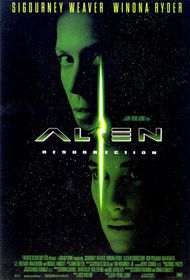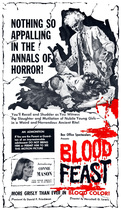Our editor-in-chief Nate Yapp is proud to have contributed to the new book Hidden Horror: A Celebration of 101 Underrated and Overlooked Fright Flicks, edited by Aaron Christensen. Another contributors include Anthony Timpone, B.J. Colangelo, Dave Alexander, Classic-Horror.com's own Robert C. Ring and John W. Bowen. Pick up a copy today from Amazon.com!
Alien: Resurrection (1997)
Alien Resurrection doesn't have any profound subtexts like Alien3. Like Aliens, it's more "Hollywoodish" than Alien or Alien3, but it's not quite as bombastic, or as successful as Aliens. But, it's not that far removed from Aliens as a prime cut of Hollywood action cum sci-fi horror, and unlike Aliens, Alien Resurrection retains much of Alien's atmosphere, making Sigourney Weaver right in her claim that it plays a bit like a genetic splicing of the first two films, which is appropriate. (By the way, I recommend a scorecard to keep all the "Alien" titles straight.)
As with the other films, Alien Resurrection is a sequel that picks up the story in the same universe, with the same history as the earlier films - it's a continuation of the same plot. As such, you need to watch the Alien saga in order, and you shouldn't read this review any further if you don't know the story up to this point. Otherwise, it's a bit like starting a novel at chapter four and robbing yourself of some suspense. Since all of my remaining readers have already seen the film (ahem), I won't bother recounting the premise or the plot en toto.
Instead, I'll comment on some specific aspects of the film. I know a lot of people will probably claim that the reappearance of Ripley was done cheaply, or that perhaps no attempt should have been made to bring her back at all, but I thought it was an excellent way to enable director Jean-Pierre Jeunet and scripter Joss Whedon to further the Alien mythology through the splicing idea, creating aliens that are human with a bit of alien, and, at the conclusion, alien with a bit of human. I also loved the idea of having Ripley find the room with the failed clones, which were excellently conceived and realized by the special effects team, giving us a full range of "half and halfs" and enabling the new Ripley to better come to terms with herself existentially.
Each Alien director has had a chance to further the mythology, and remarkably, given the fact that each film has had a different crew, the mythology has remained not only extremely intriguing, but amazingly consistent throughout the series. For that matter, the same holds for the tone of the films, which have been stylistically and thematically similar enough to unify them, but which all have individualistic artistic voices crawling above the claustrophobic interiors. That's not an easy thing to achieve, and as the series goes on, it becomes more difficult. Jeunet's turn at bat, both in light of this difficulty and if we look at Alien in isolation, produced a solid three-base hit.
The achievements of these different crews working to produce such a grand arc are also what makes the Alien saga one of the best series in the history of film thus far. I reviewed the films close to one another in time, and I think that's the best way to see them. It underscores the ingenuity of an achievement which actually spreads out over 18 years, and it provides a nice example of emergence, the whole being greater than the sum of its parts.
The idea of the new Ripley's coming-to-be in Alien Resurrection also gave Weaver a chance to do a fair bit of stretching as an actress. She nimbly expresses an adult coming to terms with the world in a child-like way at the same time that she displays her dual alien/human nature and hints of the "old Ripley." Weaver's performance in this film deserved Oscar consideration just as much as her performance in Aliens.
The rest of the cast does a great job, as well, although one minor complaint is that, like the rest of the Alien films with the exception of the first, we have more quality actors than we can get to know in the space of two hours. Winona Ryder's portrayal of this film's token android is a bit more off-the-wall than either Ian Holm's in Alien or Lance Henriksen's in Aliens or Alien3. However, it's none the worse for that, and shows an interesting possible evolution of androids over the course of close to 300 years. They move from complex machines to something more akin to humans, neuroses and all, the fruition of artificial consciousness and not just intelligence. After Weaver and Ryder, my next favorite performance in this film is probably from Ron Perlman, who gets my award for "Most Tom Waits-like performance from someone other than Tom Waits."
Alien Resurrection is also intriguing in that the "big bad corporation" - or, its equivalent here, the military - finally gets a hold of their Holy Grail of future weaponry, the aliens. Although I wouldn't have guessed as much before watching Alien Resurrection, scenes like the alien bumping against the glass, inches from the military scientist's face, are just as scary as anything in the other three films. With this development, Jeunet and Whedon realize one of the long-standing stated goals of a "character" in the alien films. Now that they've also teased us with the other, unspoken one - that is, bringing the aliens to Earth - we have to sit patiently, but anxiously, as we wait for another brave crew to step up to the plate (hopefully with Weaver at the production helm again) and continue this wonderful, nihilistic, scary and exciting fable. We can only hope that the streak will continue and that Alien 5 will be of the same outstanding quality that marks the films in the series to date.
Trivia:
Weaver shoots a behind-the-back half-court shot basket in the film. The actress made the shot on the second take without any offscreen assistance.
Ron Perlman nearly drowned during filming. In an underwater sequence, he attempted to surface, and was knocked unconscious by hitting his head on a sprinkler. He was rescued by crew members.










So damn true about Tom Waits.
So damn true about Tom Waits. Thats what I was trying to figure out. AH